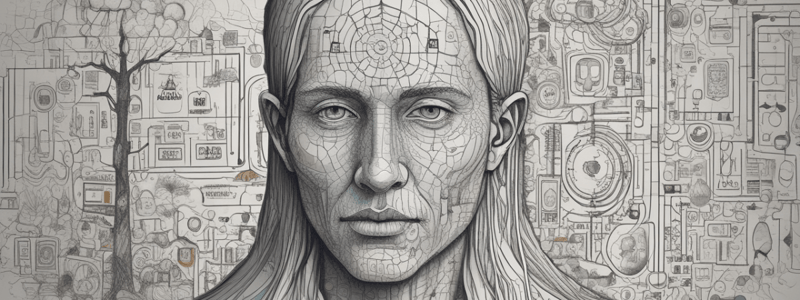Podcast
Questions and Answers
Late-onset bipolar disorder is frequently encountered in community surveys.
Late-onset bipolar disorder is frequently encountered in community surveys.
False (B)
The average length of a manic episode is approximately 3 months.
The average length of a manic episode is approximately 3 months.
False (B)
More than 90% of patients with mania have experienced further episodes of major mood disturbances.
More than 90% of patients with mania have experienced further episodes of major mood disturbances.
True (A)
Patients with bipolar II disorder tend to have a worse long-term prognosis than those with bipolar I disorder.
Patients with bipolar II disorder tend to have a worse long-term prognosis than those with bipolar I disorder.
Mortality in patients with bipolar disorder is primarily due to suicide and cardiovascular disease.
Mortality in patients with bipolar disorder is primarily due to suicide and cardiovascular disease.
The reduction in life expectancy for men with bipolar disorder is about 5 years.
The reduction in life expectancy for men with bipolar disorder is about 5 years.
Before modern drug treatments, the mortality rate of mania in hospital settings was over 30%.
Before modern drug treatments, the mortality rate of mania in hospital settings was over 30%.
The onset of bipolar disorder typically occurs later in life, around 25 years of age.
The onset of bipolar disorder typically occurs later in life, around 25 years of age.
Typical antipsychotic drugs, such as chlorpromazine and haloperidol, are effective regardless of the presence of psychotic features.
Typical antipsychotic drugs, such as chlorpromazine and haloperidol, are effective regardless of the presence of psychotic features.
Persistent cognitive deficits are associated with a better outcome in bipolar patients.
Persistent cognitive deficits are associated with a better outcome in bipolar patients.
Atypical antipsychotic agents are being used less frequently in the treatment of mania compared to typical antipsychotics.
Atypical antipsychotic agents are being used less frequently in the treatment of mania compared to typical antipsychotics.
Manic patients treated with typical antipsychotics are not at risk for extrapyramidal side effects.
Manic patients treated with typical antipsychotics are not at risk for extrapyramidal side effects.
Lithium has been shown to be effective in the acute treatment of mania in multiple placebo-controlled trials.
Lithium has been shown to be effective in the acute treatment of mania in multiple placebo-controlled trials.
Conventional antipsychotic drugs can provide protection against the depressive phases following mania resolution.
Conventional antipsychotic drugs can provide protection against the depressive phases following mania resolution.
Severely ill patients are often included in placebo-controlled trials for atypical antipsychotic agents.
Severely ill patients are often included in placebo-controlled trials for atypical antipsychotic agents.
The primary aim of drug treatment in mania is to increase physical and mental energy levels.
The primary aim of drug treatment in mania is to increase physical and mental energy levels.
Lithium has a response rate of 49%, valproate has a response rate of 48%, and placebo has a response rate of 40%.
Lithium has a response rate of 49%, valproate has a response rate of 48%, and placebo has a response rate of 40%.
Benzodiazepines are most effective when used alone in the treatment of mania.
Benzodiazepines are most effective when used alone in the treatment of mania.
Electroconvulsive therapy (ECT) has been shown to have an overall response rate of 80% in retrospective investigations for acute mania.
Electroconvulsive therapy (ECT) has been shown to have an overall response rate of 80% in retrospective investigations for acute mania.
Carbamazepine's efficacy in acute mania has been extensively validated through multiple large-scale studies.
Carbamazepine's efficacy in acute mania has been extensively validated through multiple large-scale studies.
Valproate is more effective than lithium in patients with prominent dysphoric symptoms and rapid cycling.
Valproate is more effective than lithium in patients with prominent dysphoric symptoms and rapid cycling.
Withdrawal from antipsychotics should be done rapidly to avoid adverse effects.
Withdrawal from antipsychotics should be done rapidly to avoid adverse effects.
Only bilateral ECT has been found to be effective in treating mania.
Only bilateral ECT has been found to be effective in treating mania.
The average length of a manic episode is approximately 6 months, suggesting that medication should continue for at least this duration.
The average length of a manic episode is approximately 6 months, suggesting that medication should continue for at least this duration.
The lifetime risk for bipolar disorder is estimated to be in the range of 0.5-1.0%.
The lifetime risk for bipolar disorder is estimated to be in the range of 0.5-1.0%.
Bipolar disorder does not have a significant prevalence difference between men and women.
Bipolar disorder does not have a significant prevalence difference between men and women.
The mean age of onset for bipolar disorder in community studies is estimated to be around 25 years.
The mean age of onset for bipolar disorder in community studies is estimated to be around 25 years.
Bipolar disorder has low comorbidity with anxiety disorders.
Bipolar disorder has low comorbidity with anxiety disorders.
The 6-month prevalence of bipolar disorder is significantly lower than its lifetime prevalence.
The 6-month prevalence of bipolar disorder is significantly lower than its lifetime prevalence.
Community surveys have used both ICD-9 and DSM-5 criteria for diagnosing bipolar disorder.
Community surveys have used both ICD-9 and DSM-5 criteria for diagnosing bipolar disorder.
Flashcards are hidden until you start studying
Study Notes
Epidemiology of Bipolar Disorder
- Lifetime risk of bipolar disorder: 0.3-1.5%
- 6-month prevalence of bipolar disorder is close to lifetime prevalence, indicating chronic nature of the disorder
- Prevalence in men and women is the same
- Mean age of onset: about 18 years in community studies
- Bipolar disorder is highly comorbid with anxiety disorders, substance misuse, and general medical conditions like cardiovascular disease
Treatment of Mania
General Measures
- Drug treatment plays a crucial role in managing mania
- Aim of treatment: reduce physical and mental overactivity, improve psychotic features, and prevent health deterioration
Medication
Typical Antipsychotic Drugs
- Chlorpromazine and haloperidol are effective in treating mania
- Limitations: high doses often required, susceptible to extrapyramidal side-effects, and do not protect against depressive downswings
Atypical Antipsychotic Drugs
- Aripiprazole, asenapine, olanzapine, quetiapine, and risperidone are effective in treating mania
- Improved tolerability profile compared to typical antipsychotic drugs
- May not be generalizable to more severely ill patients
Lithium
- Effective in acute treatment of mania
- Five placebo-controlled trials support its efficacy
Course and Prognosis
- Bipolar disorder usually begins as depression, with the first manic episode manifesting about 5 years later
- Average length of a manic episode: about 6 months
- At least 90% of patients with mania experience further episodes of major mood disturbance
- Interval between episodes becomes progressively shorter with age and number of episodes
- Long-term prognosis is poor, with less than 20% of patients achieving 5 years of clinical stability
Mortality of Bipolar Disorder
- Mortality is significantly increased in patients with bipolar disorders
- About 8% of men and 5% of women hospitalized for bipolar illness die by suicide
- High mortality is also due to general medical conditions like cardiovascular disease and substance misuse
- Life expectancy is reduced by about 13 years in men and 9 years in women
Treatment of Mania (continued)
Lithium
- Response rate: 49%
- As effective as antipsychotic medication, but slower onset of action
- Preferable in highly active states
- Prominent depressive symptoms and psychotic features predict a poorer response to lithium alone
- Rapid cycling disorder also predicts a poor response
Carbamazepine
- Studies have been limited by problems with study design
- Extended-release form showed a clinically significant antimanic effect
- Induces drug metabolizing enzymes in the liver, leading to lower plasma levels of other medications
Valproate
- Greater antimanic activity than placebo and equivalent to lithium
- More effective than lithium in patients with prominent dysphoric symptoms and rapid cycling
- Onset of action is earlier than other mood stabilizers
- Valproate loading (20mg/kg/day) can lead to antimanic effects within 1-4 days
- Tolerable enough for rapid dose escalation
Benzodiazepines
- Useful adjuncts in the treatment of mania
- Rapidly diminish overactivity and restore sleep
- Can be used as sole therapy, but carries a risk of disinhibition
- Most useful as an adjunct to mood stabilizers
Electroconvulsive Therapy
- Widely used to treat mania
- Bilateral ECT better than lithium
- Unilateral and bilateral ECT better than lithium and haloperidol combined
- Effective in acute mania with an overall response rate of 80%
- Also effective in mixed affective states
Continuation Treatment of Mania
- Rapid reduction of drug treatment can lead to sudden recrudescence of the manic disorder
- Medication should continue for at least 6 months
- Atypical antipsychotics decrease the risk of manic relapse
- Patients who were severely ill may be taking a mood stabilizer and an antipsychotic agent
- Withdrawal should be slow due to adverse effects of antipsychotics
Studying That Suits You
Use AI to generate personalized quizzes and flashcards to suit your learning preferences.




